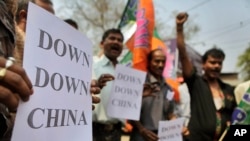China’s planned super dam on a major river that flows into India and Bangladesh threatens to turn into another in a series of flashpoints with New Delhi, and has sparked concerns in Bangladesh, which is critically reliant on the river for its fresh water supply.
The project, a megadam on the Yarlung Tsangpo river, known as the Brahmaputra in India, was announced in November by the Power Construction Corporation of China, although it has not started yet.
Analysts in India have raised several red flags – they fear the project could trigger flash floods or create water scarcity. Security experts say a dam close to China’s heavily militarized border with India would give Beijing strategic leverage as differences between the two countries intensify over disputed borders in the Himalayan mountains.
The dam is projected to be built in Tibet, along a bend in the river in the vicinity of the northeastern Indian state of Arunachal Pradesh, which Beijing claims as South Tibet. It could generate up to 60 gigawatts of power, according to Chinese state media reports – nearly three times the size of China’s Three Gorges Dam on the Yangtze river, the world’s biggest.
“For India, the primary concern is China’s unilateral action in going ahead with a project that involves trying to control the flow of water in the transnational river,” according to Jagannath Panda at the Manohar Parrikar Institute for Defense Studies and Analyses in New Delhi.
Pointing out that plans for the project have been unveiled at a time when a military standoff over their disputed border has worsened ties, he said “the Chinese are trying to link water issues with the broader border disputes to put pressure on India.”
The power generated would help Beijing meet its clean energy goals and strengthen water security, according to Yan Zhiyong, chairman of the Power Construction Corporation of China, who has called the project a “historic opportunity.”
Military experts in New Delhi, however, underline what they see as serious security ramifications for India of a megadam close to a contested border.
“When China creates a massive asset like that, it will deploy air weapons systems, develop roads, new townships would come up,” said Brigadier Arun Sahgal of the Delhi Policy Group, a think tank in New Delhi.
“If you bring such development close to a contested border, it becomes a huge red line and will constrain India in any military situation,” he said.
'Any rhetorical statements will not help'
The Chinese Embassy in New Delhi has sought to allay concerns about the project, saying that the development is at a “preliminary planning and demonstration” stage.
China has “always taken a responsible attitude toward development and utilization of cross-border rivers,” an embassy statement said last month.
“Any project will undergo scientific planning and demonstration with full consideration for the impact on the downstream areas and the interests of both upstream and downstream countries,” the statement said.
That, however, has given little comfort to New Delhi.
“Any rhetorical statements will not help,” said Panda, adding that during a tense military standoff between the two countries along their borders in 2017, Beijing did not share with New Delhi hydrological data that is considered crucial to forecast floods in India’s northeast.
That, he said, has sharpened concerns that China could use its upstream position for strategic leverage.
While India and China do not have a formal treaty on water-sharing, the two neighbors have an agreement on sharing data on water flows. Beijing has already built about a dozen small and medium-sized dams on the Yarlung Tsangpo.
Following the Chinese announcement on the latest project, an Indian official told reporters that New Delhi is also in the process of finalizing a project to build a dam on the Brahmaputra.
"This project will help offset the impact of the hydropower project by China," T.S. Mehra, a senior official in India’s Water Ministry told the Press Trust of India last month.
An article published by Australia’s Lowy Institute in July had said that India needs to assess how China might “weaponize” its advantage as an “upper riparian state” over countries downstream.
Impact on ecosystem
The Chinese project has also triggered huge concerns in Bangladesh, which fears it could be affected even more adversely than India.
Experts fear the planned dam will disturb the flow of a river crucial for sustaining livelihoods and agriculture in the densely populated country and are calling for consultations with downstream countries before the project goes ahead.
“In the dry season, the Brahmaputra river makes the most important contribution to Bangladesh,” said Malik Fida Khan, executive director of the Center for Environmental and Geographic Information Services in Dhaka.
He said the dam could do more damage than just affecting the amount of water flowing.
“You are trapping the sediment, the nutrients that are flowing from upstream and that has a huge impact on the ecosystem,” he said.
This is not the first hydropower project in China to trigger regional tensions.
In Southeast Asia, China has faced accusations that a series of dams on the Mekong River worsen water scarcities in downstream countries. Beijing has dismissed the reports.








